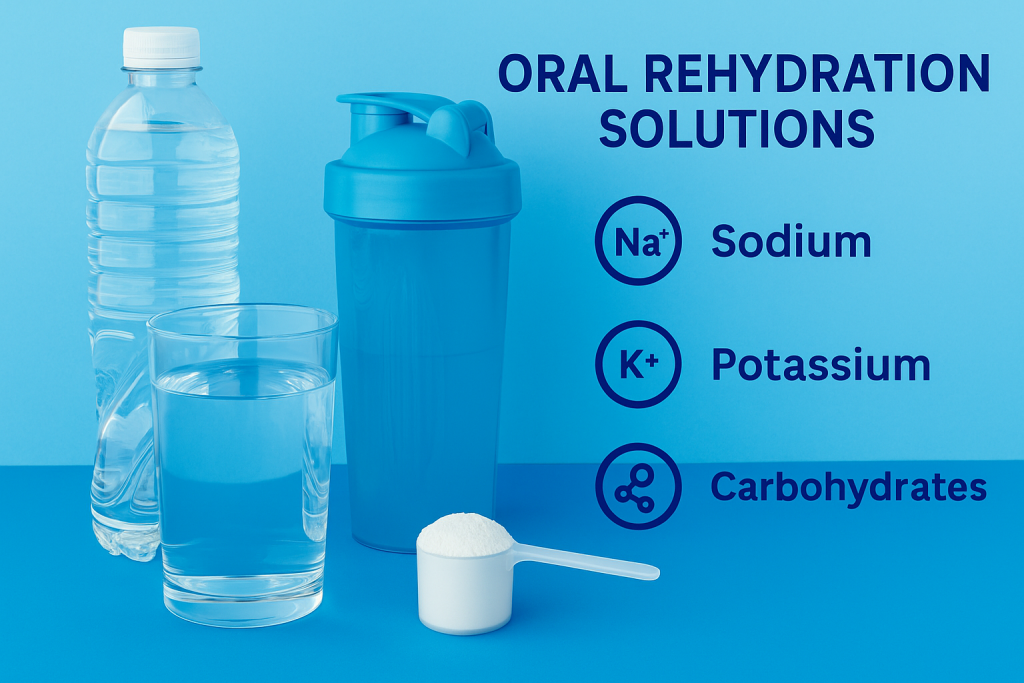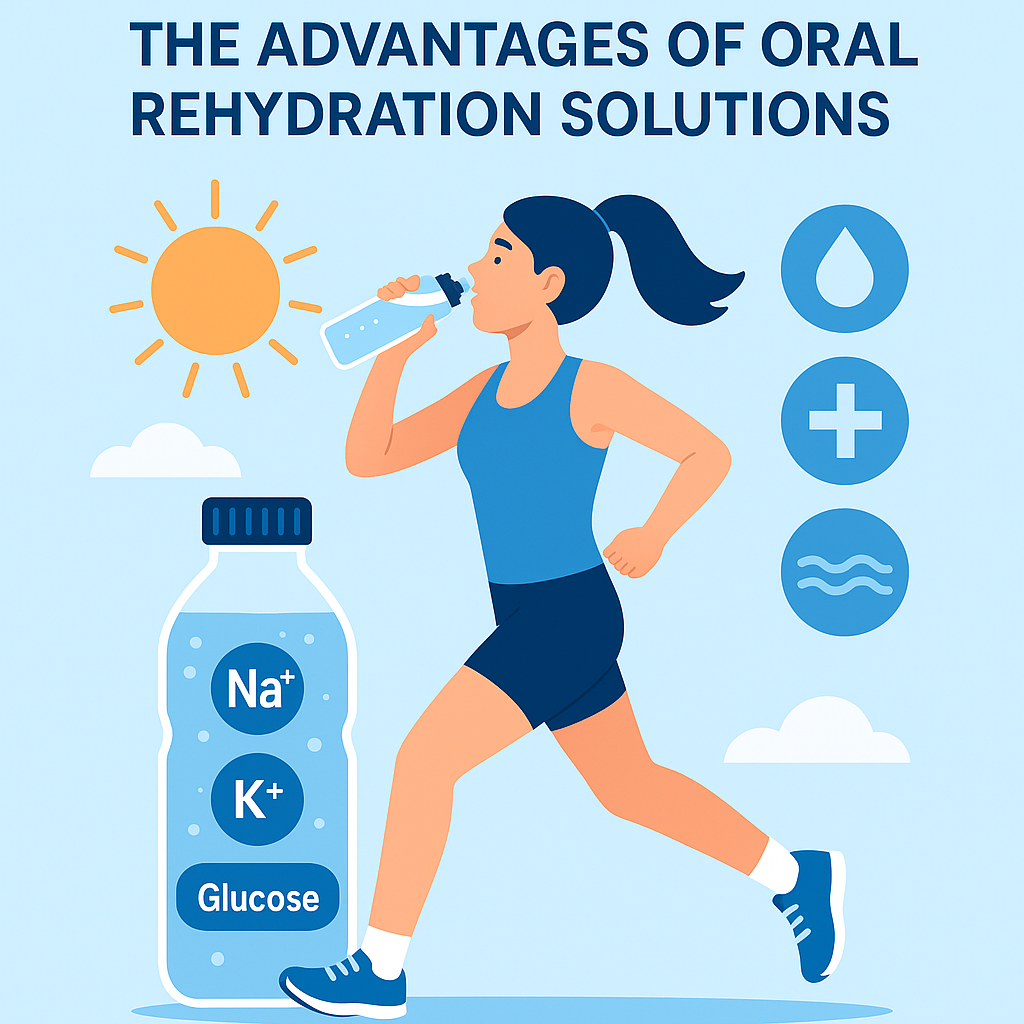Fuel Your Summer Exercise: The Advantages of Oral Rehydration Solutions (ORS)
Discover how oral rehydration solutions (ORS) improve hydration, exercise performance, and recovery. Learn the science behind electrolytes, sodium, potassium, and carbohydrates for better endurance.

Hydration, Electrolytes, and Exercise
Exercise and physical activities change the electrolyte levels and water homeostasis. The lack of water and electrolytes can result in dehydration and impaired tissue delivery of oxygen. Rehrer’s study (2001) highlights that excessive water deprivation and severe dehydration during American football training can be fatal. Dehydration can reduce exercise performance because of reduced blood flow to the muscles and skin during exercise, including other physiologic changes such as decreased plasma volume, blood pressure, blood flow to the kidneys, and impaired regulation of body temperature.
The Role of Sodium in ORS
In the last century, it was observed that sodium (Na⁺) co-transports actively with glucose in the intestine, creating an osmotic gradient which facilitates water absorption in the intestines. This mineral also creates a concentration gradient that drives water reabsorption in the renal tubules and plays a key role in stimulating thirst, as large water intake without proper sodium levels can decrease extracellular osmolality and inhibit the body’s natural thirst response.
One study in nine healthy males examined the efficacy of ingesting an oral rehydration solution (ORS) in restoring fluid balance compared with commercially available sports drinks and water during recovery after moderate-high intensity cycling exercise. The findings show higher fluid retention in participants ingesting ORS compared with regular water and sports drinks. Some of the advantages of including sodium in these solutions is maintaining higher plasma and extracellular fluid volumes, preventing further declines in plasma sodium concentration, lowering the urine output, and sustaining the osmotic drive to drink. When the sodium plasma concentrations decline, greater urine losses are stimulated by the dilution of the blood, which can present a higher risk of developing hyponatraemia. These states can occur during and after exercise in individuals consuming large volumes of fluid to replace sweat losses with fluids that contain low or no sodium concentration (Fan et al., 2020).
Potassium and Other Key Electrolytes
While sodium is the main cation in extracellular fluid, potassium (K⁺) represents the main cation in intracellular compartments. Potassium helps regulate cell volume, intracellular fluid balance, nerve signal transmission, and muscle contraction.
These two macro elements, when added to ORS, are usually conjugated with chloride as the main anion in the extracellular fluid, while also having a high excretion rate in sweat, mainly as sodium chloride. This anion can be replaced with citrate and bicarbonate anions to improve the palatability of these formulations.
Carbohydrates in ORS
Carbohydrates are also added with the purpose of maintaining a high carbohydrate oxidation rate, supporting performance during exercise, and replenishing glycogen stores in the recovery phase.
As mentioned, the carbohydrates are also added for sustaining fluid balance, mainly because of the intestinal co-transport of glucose and sodium (Pérez-Castillo et al., 2023). A recent study by Park et al. (2016) reported the effects of consuming an electrolyte drink versus regular water in 11 adult male individuals before exercise. In the group that had the electrolytes, maximum oxygen intake and exercise time were significantly increased compared to the group that consumed regular water.
One study assessed the effects of a carbohydrate-electrolyte solution on soccer performance. Twenty-two professional soccer players participated, consuming the solution or a placebo throughout the 90-minute match. The results showed that the players who consumed the carbohydrate-electrolyte enriched potion had faster dribble test times and better precision test ratings compared to the placebo group (Ostojic & Mazic, 2002).
ORS in Hot Environments
Working in a hot environment can cause loss of salts, primarily sodium, along with water loss due to intense sweating. Therefore, supplying appropriate amounts of water and electrolytes is important. ORS is ideal for intestinal absorption of water and electrolytes because of its characteristic composition, especially the sodium concentration, which is higher than commercially available sports drinks.
According to the Ishikawa study (2010), ORS intake during outdoor work in a hot environment is effective for keeping homeostasis of water and electrolytes in the body, and may help prevent industrial accidents by reducing the degree of associated fatigue.
ORS and Muscle Cramps
Muscle cramp is a painful, involuntary muscle contraction that occurs during or following exercise. The causes are multifactorial, but dehydration and electrolyte deficits are considered to be factors.
In a recent study, the results suggest that ORS intake during exercise decreased muscle cramp susceptibility, forming the conclusion that ingesting ORS appears to be effective for preventing exercise-associated muscle cramps (Lau et al., 2021).
References:
Fan, P. W., Burns, S. F., & Lee, J. K. W. (2020). Efficacy of ingesting an oral rehydration solution after exercise on fluid balance and endurance performance. Nutrients, 12(12), 3826.
Ishikawa, T., Tamura, H., Ishiguro, H., Yamaguchi, K., & Minami, K. (2010). Effect of oral rehydration solution on fatigue during outdoor work in a hot environment: a randomized crossover study. Journal of occupational health, 52(4), 209-215.
Lau, W. Y., Kato, H., & Nosaka, K. (2021). Effect of oral rehydration solution versus spring water intake during exercise in the heat on muscle cramp susceptibility of young men. Journal of the International Society of Sports Nutrition, 18, 1-9.
Ostojic, S. M., & Mazic, S. (2002). Effects of a carbohydrate-electrolyte drink on specific soccer tests and performance. Journal of sports science & medicine, 1(2), 47.
Park, S. H., Jeon, B. Y., Kim, Y. H., & Yoon, J. H. (2016). Effects of deep-sea water electrolyte supplement on blood electrolyte concentration and exercise performance during acute exercise in hot environment. Korean Soc. Living Environ. Syst, 23, 835-842.
Pérez-Castillo, Í. M., Williams, J. A., López-Chicharro, J., Mihic, N., Rueda, R., Bouzamondo, H., & Horswill, C. A. (2023). Compositional aspects of beverages designed to promote hydration before, during, and after exercise: Concepts revisited. Nutrients, 16(1), 17.
Rehrer, N. J. (2001). Fluid and electrolyte balance in ultra-endurance sport. Sports Medicine, 31, 701-715.
⚠️ Disclaimer: This content is for informational purposes only and is not a substitute for professional medical advice. Always consult your doctor or pharmacist before making health decisions.
